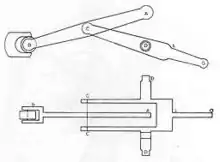Scott Russell linkage
A Scott Russell linkage gives a theoretically linear motion by using a linkage form with three portions of the links all equal, and a rolling or sliding connection. It can be used to form a right-angle change of motion, linear-to-linear.

Freemantle straight-line linkage from British Patent 2741, November 17, 1803

Animation of a Scott Russell linkage
The linkage is named for John Scott Russell (1808–1882), although watchmaker William Freemantle had already patented it in 1803.[1][2]
A different form of the linkage has been used in a front-wheel-drive vehicle with solid rear axle to control lateral movement, and with a flexing elastomeric connection instead of the rolling or sliding connection.[3]

A Scott Russell linkage on the rear axle of a 2002 Nissan Sentra
The linkage does not share the disadvantages of the asymmetric Panhard rod and although more compact than Watt's linkage has all the forces in one link.[4]
References
- British Patent 2741, November 17, 1803
- Project Gutenberg: KINEMATICS OF MECHANISMS FROM THE TIME OF WATT, Eugene S. Ferguson
- US Patent 6179328
- Article about the Scott-Russell linkage used in the Nissan Sentra
External links
| Wikimedia Commons has media related to Scott Russell linkage. |
This article is issued from Wikipedia. The text is licensed under Creative Commons - Attribution - Sharealike. Additional terms may apply for the media files.